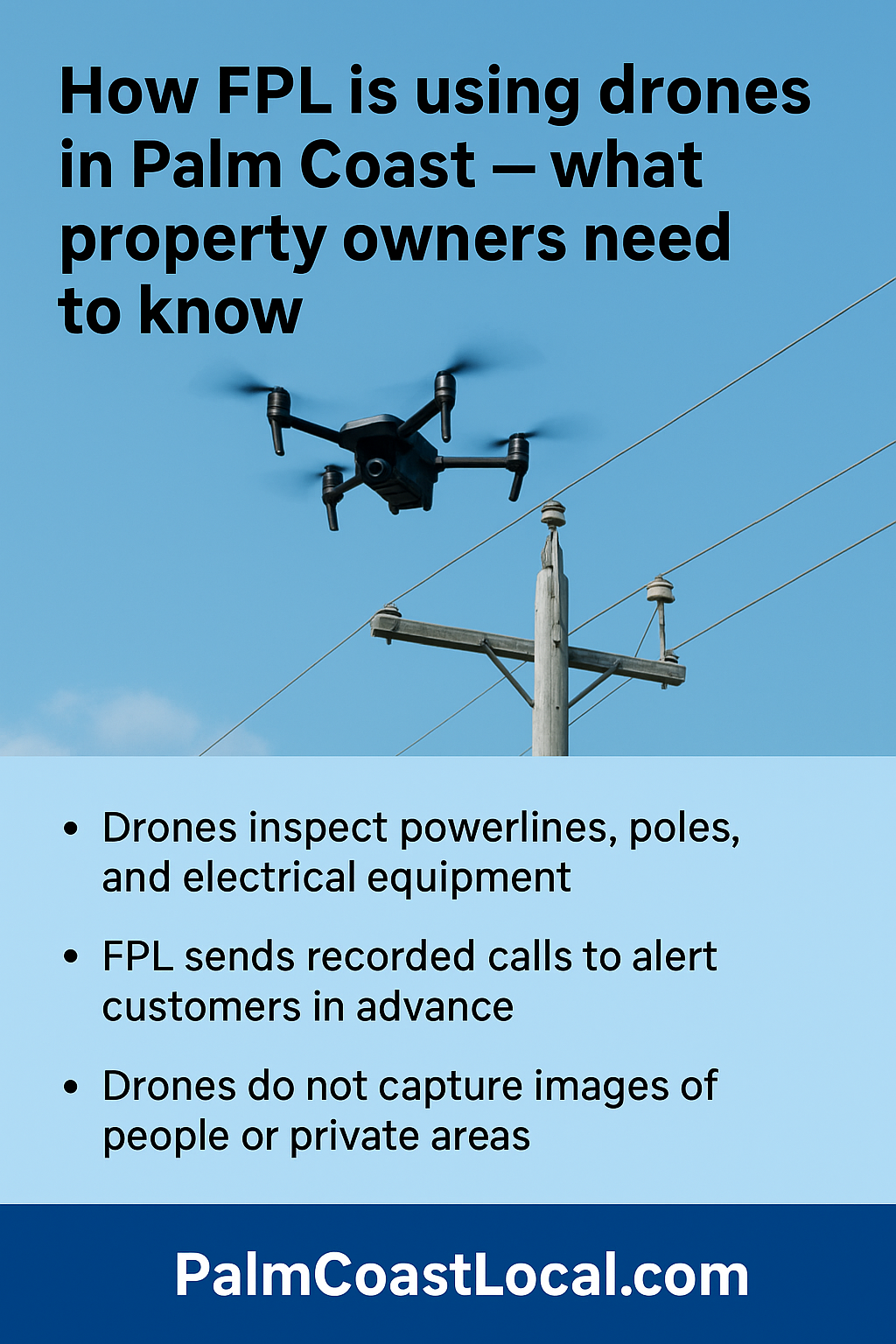Palm Coast Local
Locals Helping Locals

How FPL is using drones to monitor grids in Palm Coast.
- Details
- Written by: Palm Coast Local
- Parent Category: Business Blog
- Category: Local Community Palm Coast
- Hits: 2362

How FPL is using drones in Palm Coast — what property owners need to know.
(PSA: Palm Coast, Florida) Florida Power & Light (FPL) has been expanding drone use across its service area to inspect and monitor electric infrastructure — from poles and overhead lines to substations and other equipment. In Palm Coast you may soon see (or already have seen) low-flying drones doing maintenance assessments. Here’s what that means for property owners, why FPL is doing it, how they notify customers, and simple steps you can take if you see drone activity near your home.
Why FPL uses drones (the benefits)
- Faster, more frequent inspections. Drones can survey long stretches of lines and many poles quickly, letting FPL spot worn equipment, corrosion, vegetation encroachment, hot spots, and other problems before they cause outages.
- Safer for workers. Inspecting from the air reduces the need for crews to climb poles or send helicopters into risky conditions.
Governing - Better storm response. After hurricanes or floods, drones provide fast situational awareness in areas crews can’t safely reach yet. Some FPL drones are even built to operate in high winds for rapid post-storm assessment.
- High-quality data. Drones can carry high-resolution cameras, thermal sensors and LiDAR — capturing detail that helps prioritize repairs and vegetation trimming.
What FPL drones inspect (and what they don’t)
Yes — overhead powerlines, crossarms, insulators, transformers, pole hardware, distribution equipment, and substations are primary targets. Drone-in-a-box (autonomous) units and long-range fixed-wing craft are used for different tasks.
No interior or “private” surveillance. FPL’s public guidance says drones capture visuals of FPL equipment (poles, lines, transformers) and are not intended to capture images or video of people. Data is stored securely and not distributed broadly.
Meters: FPL’s published drone program focuses on grid infrastructure (lines, poles, transformers, substations). Smart meters operate on secure wireless networks and are usually handled separately; FPL’s drone pages do not present drone meter-reading as a routine drone function. If a drone captures a view of exterior-mounted equipment while inspecting a pole or transformer, that is treated as part of the infrastructure inspection (not a privacy invasion).
How FPL notifies customers (recorded audio and other alerts)
Automated recorded phone calls. FPL says it makes an effort to notify customers in advance of drone assessments and that customers will receive a phone call with an automated voice recording days before drone flights in their area. Local municipalities also sometimes post community notices when flights are scheduled.
On-site ID & markings. Drone pilots are licensed and the crews display FPL-branded vehicle magnets, safety vests and/or lawn signs; pilots carry contractor photo IDs. Flights are conducted by trained pilots and contractors following FAA rules.
Typical hours. Local notices show many proactive assessments occur during weekday daylight hours (for example, roughly 8 a.m. to 5 p.m.). If you receive a recorded call, it will usually state the dates/times FPL plans to operate in your neighborhood.
Safety, regulations, and privacy — what FPL says
FAA compliance. FPL operates under FAA rules and in some cases has sought FAA waivers to fly beyond visual line of sight for specific drones (e.g., drone-in-a-box systems). All flights include safety checks and follow flight regulations.
Privacy statement. FPL’s publicly posted policy emphasizes privacy: drones are used to capture images of company equipment and the visuals are not used to capture people — imagery is retained in secure systems. If you’re concerned about what a particular image shows, FPL directs customers to contact customer service.
What Palm Coast property owners can expect
A recorded phone call in advance. If you’re on file with FPL, expect an automated call a few days before assessments in your area that gives an approximate window. The call typically comes from FPL’s customer notification service; if you miss it there’s usually a message left or local municipal notices.
Seeing branded crews on the ground and a small drone overhead. Pilots may park in a marked vehicle nearby; they’ll carry ID and wear safety vests. Drone flights are usually at slow speeds near the equipment being inspected.
Limited disruption. These flights are routine inspections — you shouldn’t expect service interruptions caused by the drone itself. Drone data is used to plan repairs or vegetation work, which could trigger future notices for scheduled outages or trimming.
If you’re concerned or see unusual activity. Call FPL customer service (1-888-988-8249) — FPL asks customers to call if they’re suspicious. For immediate safety issues, call local authorities as well.
FAQs for homeowners
Q: Will the drone photograph my house or my family?
A: FPL states drones are focused on FPL equipment (poles, lines, transformers). They say they do not capture images or video of people and that imagery is restricted to equipment inspections. If you have privacy concerns, call FPL Customer Service.
Q: Should I move my pets or drones?
A: It’s sensible to keep pets secured while a drone is operating nearby (unfamiliar noise can upset animals). If you operate a private drone, don’t fly it near FPL drone operations — that can be dangerous and violates FAA rules.
Q: Could a drone trigger a service visit or meter replacement?
A: Yes — if drone imagery reveals damaged equipment (including pole-mounted transformers or otherwise visible devices), FPL may schedule a crew visit or maintenance. That visit would follow normal contractor/crew notification processes.
Q: What if I don’t want FPL flying near my property?
A: Because the drones inspect FPL infrastructure (often in public right-of-way or on FPL equipment mounted on private property), FPL’s routine inspections are part of their maintenance responsibilities. If you have an unusual concern, contact FPL Customer Service to discuss the specific location and issue.
Quick checklist — what to do if you get a recorded call about drone flights
Confirm the call is from FPL (check the number shown and call FPL Customer Service at 800-226-3545 if unsure call FPL custoner service for cinfirmation.
Keep pets secure during the stated inspection window.
Don’t approach or interfere with drone pilots or equipment. Pilots will have contractor ID and branded vehicles.
If you see suspicious drone activity outside the stated window, call FPL and/or local law enforcement.
Bottom line for Palm Coast property owners
FPL’s drone program is intended to improve reliability and speed repairs by spotting problems early and helping crews respond more quickly after storms. You will likely get an automated recorded phone call before assessments in your area; pilots will wear ID and operate within FAA rules; and imagery is used only to assess FPL equipment. If you have questions or privacy concerns, call FPL Customer Service or visit FPL’s drone page for details.